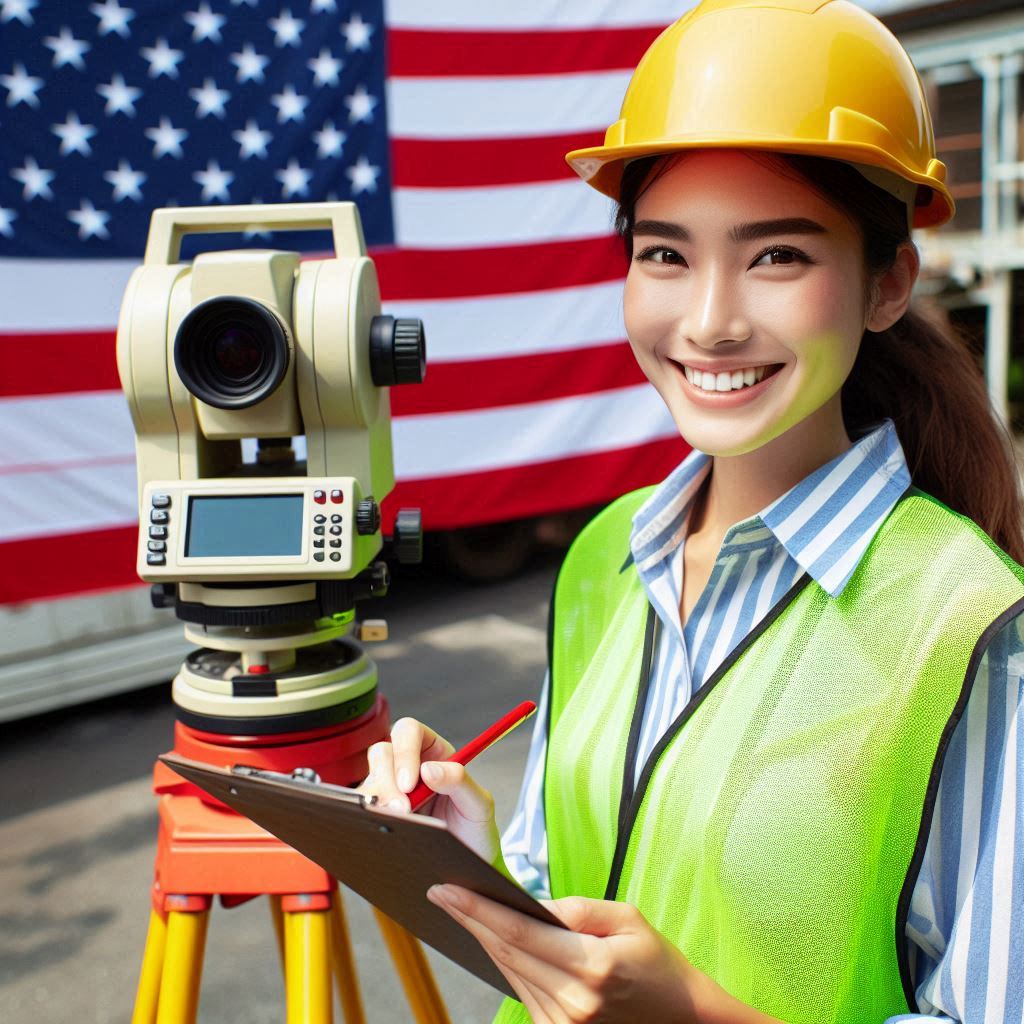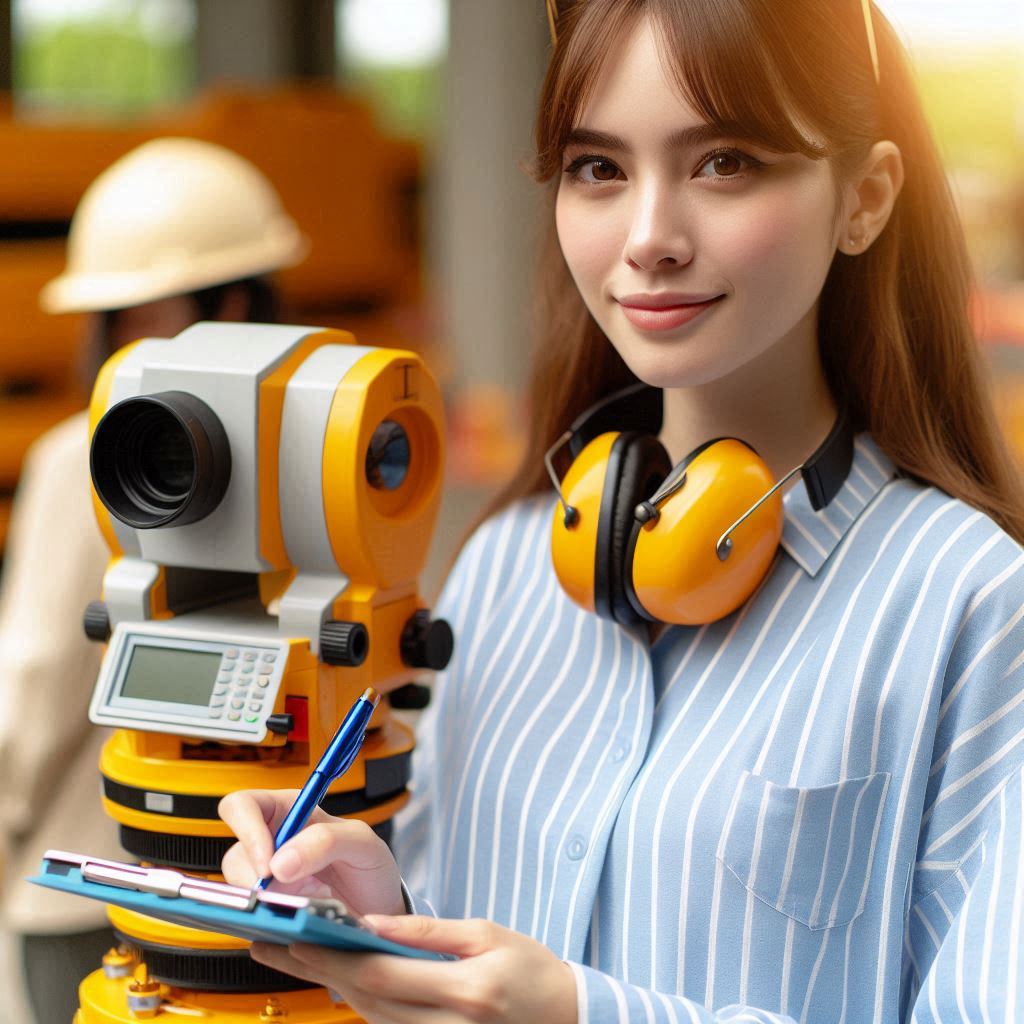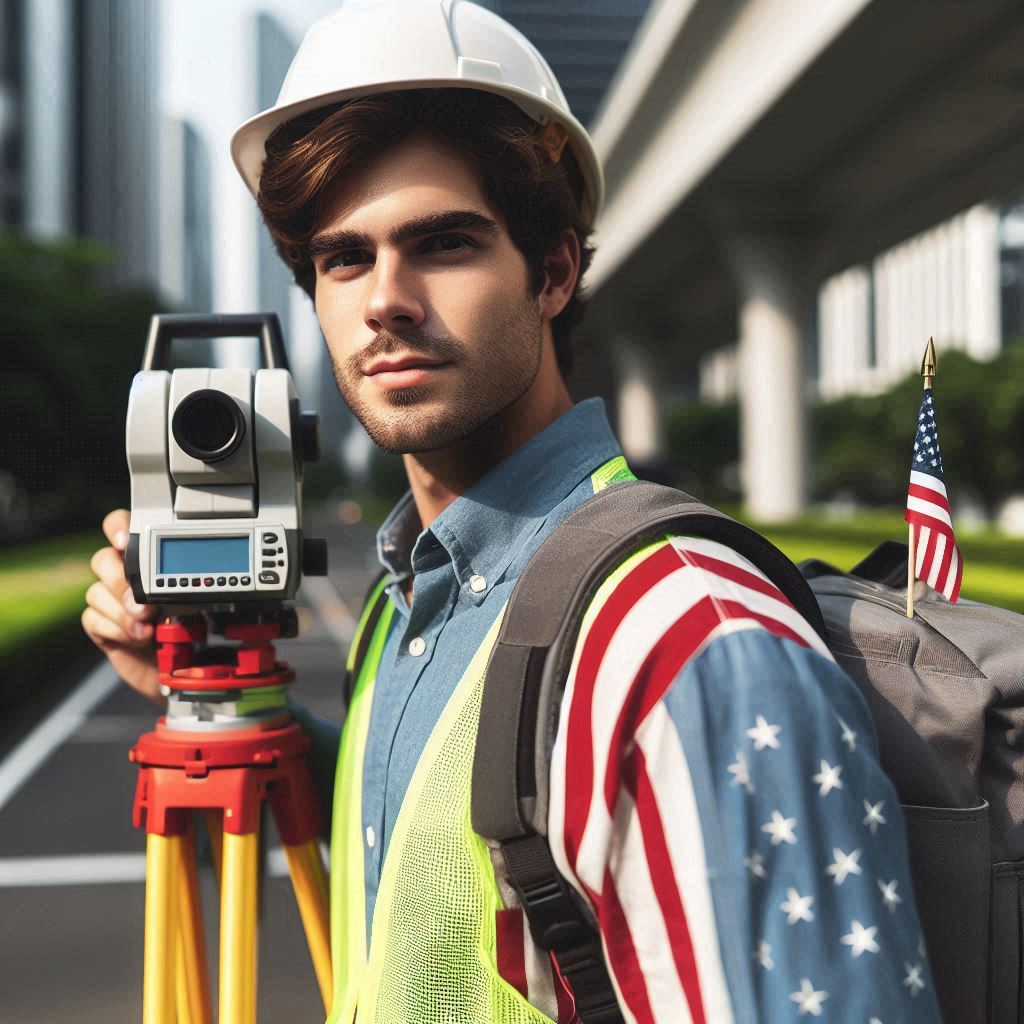Introduction
Recent trends in surveying and mapping technologies are dramatically reshaping the landscape of these fields.
Staying abreast of the latest advancements is essential for professionals to maintain a competitive edge.
The integration of new technologies such as drones, LiDAR (Light Detection and Ranging), and Geographic Information Systems (GIS) is revolutionizing how data is collected, analyzed, and utilized.
Importance of Staying Updated
Keeping up with technological advancements in surveying and mapping is crucial for several reasons.
First, these innovations enhance accuracy and efficiency in data collection.
Drones, for instance, offer high-resolution aerial imagery that improves the detail and precision of mapping projects.
LiDAR technology provides highly accurate distance measurements, essential for creating detailed topographic maps.
GIS systems allow for the integration of diverse data sources, facilitating comprehensive spatial analysis and informed decision-making.
Impact on Various Industries
The impact of these technologies extends across numerous industries.
In the construction sector, advanced surveying tools streamline project planning and monitoring.
Drones and LiDAR help in creating precise site plans and tracking progress, reducing errors and improving project outcomes.
In agriculture, these technologies optimize land use and crop management.
Drones equipped with multispectral sensors can assess crop health and monitor field conditions, allowing farmers to make data-driven decisions and improve yields.
LiDAR data helps in precision agriculture by providing detailed topographic information, which is crucial for efficient irrigation and soil management.
Urban planning also benefits significantly from these advancements.
Accurate data from drones and LiDAR supports better infrastructure development and city management.
GIS systems enable planners to analyze spatial relationships and make informed decisions about land use, transportation, and public services.
Basically, recent trends in surveying and mapping technologies are profoundly impacting various industries.
By adopting new tools and methods, professionals can enhance accuracy, efficiency, and decision-making.
Staying updated with these advancements ensures that surveying and mapping experts can leverage the latest innovations for improved project outcomes and industry leadership.
LiDAR Technology
Define LiDAR and Its Application in Surveying and Mapping
LiDAR, which stands for Light Detection and Ranging, is a remote sensing technology.
It uses laser pulses to measure distances to the Earth’s surface.
In surveying and mapping, LiDAR provides precise, three-dimensional information about terrain and structures.
This technology captures detailed and accurate spatial data, making it invaluable for various applications.
Surveyors use LiDAR to create high-resolution digital elevation models and detailed topographic maps.
It helps in generating accurate 3D models of landscapes, buildings, and infrastructure.
The Benefits of LiDAR Technology Such as High Accuracy and Fast Data Collection
LiDAR technology offers significant benefits, including exceptional accuracy and rapid data collection.
The precision of LiDAR measurements can reach within centimeters, providing highly reliable data.
This high accuracy is crucial for detailed topographic mapping and structural analysis.
Additionally, LiDAR systems collect data quickly over large areas, reducing the time required for field surveys.
The technology can scan vast landscapes in a fraction of the time needed for traditional methods.
This efficiency results in faster project completion and reduced costs.
LiDAR also operates effectively in various conditions, including low light and challenging terrain, making it versatile for different surveying environments.
Examples of How LiDAR Is Being Used in Different Projects Around the World
LiDAR technology is being utilized in diverse projects globally, showcasing its versatility.
In the United States, LiDAR helps manage and monitor forests, tracking tree heights and canopy cover for conservation efforts.
In Japan, LiDAR is used to assess earthquake damage and create detailed 3D models for disaster response.
Australia employs LiDAR to map flood risks and manage water resources efficiently.
In Europe, LiDAR aids in urban planning by providing accurate data for infrastructure development and historical preservation.
Furthermore, LiDAR is instrumental in archaeological research in Central America, revealing ancient structures hidden beneath dense jungle canopies.
Each of these examples highlights how LiDAR technology enhances data accuracy, speeds up processes, and provides valuable insights across various sectors.
Drones in Surveying
How Drones Are Revolutionizing Surveying and Mapping Processes
Drones bring a new dimension to surveying and mapping by providing aerial perspectives that were previously difficult to obtain.
They capture high-resolution imagery and detailed data from above, which enhances the accuracy and completeness of surveys.
Traditionally, surveying required extensive ground-based efforts, often involving labor-intensive and time-consuming methods.
With drones, surveyors can cover large areas rapidly and efficiently.
They are particularly valuable for capturing detailed data over expansive or difficult terrains where traditional methods may struggle.
Drones are equipped with advanced sensors and cameras that can collect various types of data, including visual, infrared, and LiDAR.
This data is then processed to create accurate 3D models and detailed maps, offering a comprehensive view of the surveyed area.
Advantages of Using Drones for Data Collection
The use of drones in data collection presents several notable advantages.
One of the primary benefits is cost-effectiveness.
Drones significantly reduce the need for expensive equipment and extensive manpower, cutting down on operational costs.
They automate many aspects of data collection, reducing the time and labor required for surveys.
This automation leads to faster project completion and more frequent updates, which can be crucial for dynamic projects.
Additionally, drones minimize human error by providing consistent and precise data collection methods.
They capture detailed imagery and measurements that contribute to higher accuracy in final reports and analyses.
This increased efficiency also translates to more immediate data availability, allowing for quicker decision-making and project adjustments.
Challenges and Limitations of Using Drones in Surveying Projects
Despite their advantages, drones face several challenges and limitations that surveyors must navigate.
Regulatory compliance is a significant challenge, as drone operations are subject to various regulations and legal requirements.
Operators need to obtain the necessary permits and adhere to restrictions that can vary by region and project type.
Weather conditions also pose a challenge for drone operations.
Drones are sensitive to environmental factors such as high winds, rain, or low visibility, which can affect their performance and the quality of data collected.
In adverse weather conditions, drones may be unable to complete their flights or may gather suboptimal data.
Battery life is another limitation.
Most drones have limited flight durations, necessitating frequent recharging or battery changes during extended surveys.
This can affect the efficiency of data collection, especially for large-scale projects.
Furthermore, operating drones requires skilled personnel who are trained in both the technology and data analysis.
Ensuring that operators are adequately trained is crucial for maximizing the effectiveness of drones and interpreting the collected data accurately.
Therefore, drones are transforming surveying and mapping by offering cost-effective, efficient, and accurate data collection methods.
They provide significant advantages, including reduced labor costs and improved data precision.
However, challenges such as regulatory compliance, weather conditions, and battery life must be addressed.
As drone technology advances, these challenges are likely to be mitigated, further enhancing the capabilities and impact of drones in the surveying and mapping industry.
Artificial Intelligence and Machine Learning
How AI and Machine Learning Are Being Integrated into Surveying and Mapping Technologies
AI and machine learning are revolutionizing surveying and mapping technologies.
These advancements enable more efficient data collection and analysis. AI algorithms process vast amounts of data quickly and accurately.
Machine learning models improve over time by analyzing data patterns and outcomes.
These technologies help surveyors automate repetitive tasks and enhance precision.
AI systems can analyze aerial and satellite images to identify features and changes in landscapes.
Integration of AI into surveying and mapping enhances decision-making and operational efficiency.
The Benefits of Using AI for Data Analysis, Pattern Recognition, and Automation of Workflows
AI significantly benefits data analysis in surveying and mapping.
It processes large datasets faster than traditional methods, revealing insights more efficiently.
Machine learning algorithms recognize patterns in data that humans might miss, improving accuracy.
For example, AI can detect and classify terrain features from satellite images, aiding in more detailed mapping.
Automation of workflows reduces manual labor and human error.
AI-driven tools streamline tasks like data entry and image analysis, freeing up surveyors to focus on complex decision-making.
This increased efficiency and accuracy lead to better project outcomes and cost savings.
Examples of Innovative AI Applications in the Field of Surveying and Mapping
Several innovative AI applications are transforming surveying and mapping.
One example is the use of AI in LiDAR data processing.
AI algorithms analyze LiDAR data to identify and classify objects such as buildings and vegetation.
Another example is AI-powered drones that capture high-resolution images and use machine learning to create detailed 3D models of terrain.
AI also enhances predictive analytics in urban planning by analyzing historical data to forecast future developments.
Additionally, AI applications like automated feature extraction from satellite imagery improve the speed and accuracy of land surveys.
These innovations demonstrate how AI and machine learning are advancing the field, making surveying and mapping more efficient and precise.
Read: Environmental Engineering and Marine Conservation
Mobile Mapping Systems
Define Mobile Mapping Systems And Their Role In Improving Data Collection And Mapping Accuracy
Mobile mapping systems are advanced technologies that utilize sensors and cameras mounted on vehicles or drones to collect geospatial data.
These systems capture high-resolution images, 3D point clouds, and other relevant data while the vehicle or drone moves.
This process enables the accurate and efficient mapping of large areas.
Mobile mapping systems play a crucial role in improving data collection and mapping accuracy.
By capturing data on the move, they reduce the time required for traditional survey methods, making them ideal for large-scale projects.
The role of mobile mapping systems in enhancing data accuracy cannot be overstated.
These systems provide real-time data collection, ensuring that the information gathered reflects current conditions.
Unlike static surveying methods, mobile mapping systems can quickly cover vast areas, allowing for comprehensive data collection in a fraction of the time.
This speed and accuracy are essential for projects requiring up-to-date information, such as urban planning, infrastructure development, and environmental monitoring.
Advantages of Using Mobile Mapping Systems
Using mobile mapping systems offers several advantages for capturing geospatial data in real-time.
One key advantage is the ability to collect data quickly and efficiently.
Traditional methods often require extensive time and labor, while mobile mapping systems streamline the process.
Real-time data collection allows for immediate analysis and decision-making, which is crucial for dynamic projects and fast-paced environments.
Another advantage is the high level of detail and accuracy provided.
Mobile mapping systems can capture precise measurements and high-resolution imagery, offering a comprehensive view of the surveyed area.
This level of detail enhances the quality of the data and supports more accurate analysis and planning.
Additionally, mobile mapping systems reduce the need for manual data entry and minimize human error, further improving data reliability.
Latest Advancements in Mobile Mapping Technology
Recent advancements in mobile mapping technology have further enhanced its capabilities.
One notable advancement is the integration of artificial intelligence (AI) and machine learning.
These technologies improve data processing and analysis by automating feature recognition and identifying patterns in large data sets.
AI algorithms can enhance object detection, classification, and even predictive analysis, making mobile mapping systems more powerful and efficient.
Another advancement is the development of more compact and versatile mapping systems.
Modern mobile mapping units are smaller and more adaptable, allowing them to be mounted on various platforms such as vehicles, drones, or handheld devices.
These versatile systems provide flexibility in data collection, making it easier to survey different types of terrain and environments.
Additionally, advancements in sensor technology have improved the accuracy and range of mobile mapping systems.
New sensors offer higher resolution and better performance in various conditions, including low-light environments and challenging weather.
These improvements ensure that mobile mapping systems can deliver reliable and detailed data in a wider range of scenarios.
Read: How to Stay Updated in Environmental Engineering Field

Indoor Mapping and Navigation
Importance of Indoor Mapping and Navigation
Indoor mapping plays a crucial role in facilities management and navigation within large buildings.
Navigating complex indoor spaces like airports, shopping malls, hospitals, and office buildings can be challenging.
Transform Your Career Today
Unlock a personalized career strategy that drives real results. Get tailored advice and a roadmap designed just for you.
Start NowIndoor mapping provides accurate location information for both visitors and facility managers to easily locate rooms, amenities, and other points of interest.
Facility managers can use indoor mapping to optimize space utilization, improve security protocols, and enhance the overall user experience.
Challenges in Indoor Mapping
One of the main challenges in indoor mapping is signal interference, which can disrupt the accuracy of location services.
Limited GPS coverage indoors poses another challenge, as GPS signals struggle to penetrate building structures, resulting in inaccurate positioning data.
Creating detailed indoor maps can also be time-consuming and labor-intensive, especially for large and complex buildings with multiple floors and departments.
Maintaining the accuracy and updating indoor maps regularly to reflect changes in the building layout can be a daunting task for facility managers.
Latest Solutions and Technologies for Indoor Mapping
To address the challenges in indoor mapping, various innovative solutions and technologies have emerged in recent years.
Indoor positioning systems (IPS) use Wi-Fi, Bluetooth, RFID, or other wireless technologies to provide accurate location information within buildings.
Mapping software with 3D modeling capabilities allows for the creation of detailed indoor maps with interactive features for navigation and wayfinding.
Augmented reality (AR) applications overlay digital information on real-world views, enhancing indoor navigation experiences for users.
Indoor mapping and navigation technologies are revolutionizing the way we navigate indoor spaces and manage facilities.
Despite the challenges involved, the growing importance of indoor mapping for facilities management cannot be understated.
By leveraging the latest solutions and technologies, organizations can improve efficiency, enhance user experiences, and optimize space utilization indoors.
As these technologies continue to evolve, we can expect even more advanced indoor mapping solutions to emerge, making indoor navigation seamless and intuitive.
Read: Environmental Engineering and Corporate Social Responsibility
Delve into the Subject: Biomedical Engineering: Innovations and Advances
Gain More Insights: Top Industries Hiring Telecommunications Technicians
3D Scanning and Modeling
The Significance of 3D Scanning and Modeling in Surveying and Mapping
3D scanning and modeling have become game-changers in surveying and mapping.
These technologies capture detailed spatial data and create accurate digital replicas of real-world environments.
By using laser scanners and photogrammetry, professionals can produce high-resolution 3D models that enhance both analysis and visualization.
This advancement improves the precision of data and the efficiency of project workflows.
Creating Detailed Digital Replicas
3D technologies work by capturing millions of data points from a physical environment.
Laser scanners emit lasers that measure distances based on the time it takes for the laser to return.
This data is then used to generate a point cloud, which forms the basis of the 3D model.
Photogrammetry, on the other hand, uses overlapping photographs to create detailed 3D representations.
Both methods allow for the creation of highly accurate digital replicas, providing a comprehensive view of structures, landscapes, and infrastructures.
These digital models facilitate better planning, analysis, and design by offering a realistic and detailed perspective of the surveyed area.
Examples of Industries Benefiting from 3D Scanning and Modeling
Several industries are seeing significant benefits from 3D scanning and modeling technologies
Transform Your Career Today
Unlock a personalized career strategy that drives real results. Get tailored advice and a roadmap designed just for you.
Start Now- Construction: In the construction industry, 3D scanning provides accurate as-built models, aiding in project coordination and reducing errors. Detailed models help in visualizing construction progress, verifying compliance with design specifications, and improving quality control.
- Architecture: Architects use 3D modeling to create detailed representations of buildings and landscapes. This allows for better design visualization and client presentations. Accurate 3D models help architects to refine their designs and make informed decisions.
- Urban Planning: Urban planners utilize 3D models to visualize new developments and assess their impact on existing infrastructure. These models support better planning and decision-making by providing a realistic view of how changes will affect the urban environment.
- Cultural Heritage: In archaeology and cultural heritage, 3D scanning preserves and documents historical sites and artifacts. Digital replicas allow researchers to study and analyze artifacts without physical handling, reducing the risk of damage.
- Mining and Geology: The mining industry uses 3D models for resource estimation and mine planning. Accurate digital models help in assessing the size and shape of mineral deposits, leading to more efficient extraction processes.
In summary, 3D scanning and modeling offer significant advantages across various industries by providing detailed, accurate digital replicas of real-world environments.
These technologies enhance precision, improve project efficiency, and support better decision-making and visualization.
As 3D technologies continue to evolve, their applications and benefits in surveying and mapping will only grow, driving further innovation and efficiency in these fields.
Read: The Future of Environmental Engineering Jobs
See Related Content: Top Skills Needed for a Telecommunications Technician Career
Satellite Imaging
Role of Satellite Imaging in Surveying and Mapping Applications
Satellite imaging plays a pivotal role in modern surveying and mapping.
It offers extensive coverage and detailed views of large areas, which traditional methods often cannot match.
By capturing images from space, satellite technology provides a broad perspective on geographic features, land use, and infrastructure.
This data is invaluable for creating accurate maps and performing complex spatial analyses.
Advantages of Using Satellite Data
Satellite data offers several advantages for monitoring land use changes, environmental conditions, and disaster responses.
For land use monitoring, satellites provide regular, updated imagery that tracks changes over time.
This capability helps urban planners and developers make informed decisions based on current land use trends.
In environmental monitoring, satellite data is essential for tracking vegetation health, water resources, and pollution levels.
The technology allows scientists to observe and analyze environmental changes on a global scale, providing insights into climate change and ecosystem health.
Satellite imaging is also critical for disaster response.
During natural disasters like hurricanes, floods, or wildfires, satellites deliver real-time images that aid in assessing damage and coordinating response efforts.
These images help emergency services to deploy resources more effectively and evaluate the impact of the disaster on affected areas.
Recent Advancements in Satellite Imaging Technology
Recent advancements in satellite imaging technology have significantly improved data quality and accessibility.
High-resolution satellites now offer images with unprecedented detail, capturing smaller features and providing clearer insights.
Multispectral and hyperspectral imaging technologies enable the detection of various materials and conditions not visible in standard imagery.
These advancements enhance the ability to monitor vegetation health, detect pollutants, and analyze geological features.
Additionally, the integration of artificial intelligence (AI) with satellite data has revolutionized image analysis.
AI algorithms can process large volumes of data quickly, identifying patterns and changes that might be missed by human analysts.
This integration speeds up data processing and improves the accuracy of interpretations.
New satellite constellations, such as those from private companies, increase the frequency of imagery updates.
These constellations provide more regular and timely data, allowing for more responsive monitoring and decision-making.
In summary, satellite imaging is transforming surveying and mapping with its expansive coverage and detailed data.
It offers significant advantages in monitoring land use changes, environmental conditions, and disaster response.
Recent advancements in technology, including high-resolution imagery, multispectral sensors, AI integration, and new satellite constellations, are enhancing the capabilities and applications of satellite data.
These trends continue to shape the future of surveying and mapping, providing more precise and actionable insights.
Conclusion
Recent trends in surveying and mapping technologies have introduced significant advancements that are reshaping the industry.
Technologies such as drone usage, LiDAR advancements, and Geographic Information Systems (GIS) innovations have become essential tools for modern surveying and mapping professionals.
Drones provide high-resolution aerial imagery, which enhances data collection and analysis from previously unreachable perspectives.
LiDAR technology offers precise 3D mapping capabilities, allowing for detailed and accurate terrain modeling.
Meanwhile, GIS integrates and analyzes spatial data, enabling comprehensive and informed decision-making.
Embracing these new technologies is crucial for staying competitive in today‘s rapidly evolving field.
The integration of advanced tools and methods not only improves the accuracy and efficiency of surveying and mapping projects but also helps professionals deliver higher-quality results.
As technology continues to advance, the ability to leverage these innovations becomes a key differentiator in the industry.
To remain at the forefront of the field, it is essential for professionals to stay informed about the latest advancements.
This involves regularly updating knowledge and skills to keep pace with emerging technologies.
Attending industry conferences, participating in training sessions, and engaging with professional networks can help in staying current.
Additionally, actively seeking out new tools and methods to incorporate into your work can provide a competitive edge.




